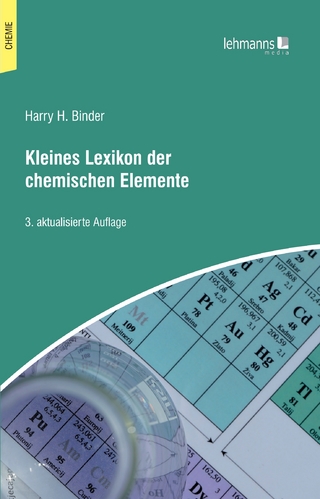
Basic Concepts of Chemistry
John Wiley & Sons Ltd (Verlag)
978-0-470-39890-6 (ISBN)
- Titel ist leider vergriffen;
keine Neuauflage - Artikel merken
PROLOGUE INTRODUCTION TO THE STUDY OF CHEMISTRY A. The Creation of Matter B. The Mystery of Fire C. The Scientific Method D. The Study of Chemistry and Using This Textbook CHAPTER 1 MEASUREMENTS IN CHEMISTRY Part A The Numbers Used in Chemistry 1-1 The Numerical Value of a Measurement 1-1.1 The Qualities of a Number 1-1.2 Zero as a Significant Figure 1-2 Significant Figures and Mathematical Operations 1-2.1 Rules for Addition and Subtraction and Rounding Off 1-2.2 Rules for Multiplication and Division 1-3 Expressing Large and Small Numbers: Scientific Notation 1-3.1 Changing Numbers into Scientific Notation 1-3.2 Mathematical Manipulation of Scientific Notation Key Terms and Summary Charts in Part A Part B The Measurements Used in Chemistry 1-4 Measurement of Mass, Length, and Volume 1-4.1 The English System of Measurements 1-4.2 The Metric System of Measurements 1-4.3 The Prefixes Used in the Metric System 1-4.4 Relationships Between the Metric and English Systems 1-5 Conversion of Units by the Factor-Label Method 1-5.1 Relationships as Conversion Factors 1-5.2 One Step Conversions and Unit Maps 1-5.3 Multistep Conversions 1-6 Measurement of Temperature 1-6.1 Thermometer Scales 1-6.2 Relationships Between Scales Key Terms and Summary Charts in Part B Chapter Review CHAPTER 2 ELEMENTS AND COMPOUNDS Part A The Elements and Their Composition 2-1 The Elements 2-1.1 Free Elements in Nature 2-1.2 The Names of Elements 2.1.3 The Distribution of the Elements 2-1.4 The Symbols of the Elements 2-2 The Composition of Elements: Atomic Theory 2-2.1 The Atomic Theory 2-2.2 The Size of an Atom 2-3 Composition of the Atom 2-3.1 The Electron and Electrostatic Forces 2-3.2 The Nuclear Model of the Atom 2-3.3 The Particles in the Nucleus 2-4 Atomic Number, Mass Number, and Atomic Mass 2-4.1 Atomic Number, Mass Number, and Isotopes 2-4.2 Isotopic Mass and Atomic Mass Key Terms and Summary Charts in Part A Part B Compounds and Their Composition 2-5 Molecular Compounds 2-5.1 Recognizing the Names of Compounds 2.5.2 Molecules, Molecular Compounds, and Covalent Bonds 2-5.3 The Formulas of Molecular Compounds 2.5.4 Molecular Elements 2-6 Ionic Compounds 2-6.1 Cations and Anions 2-6.2 The Origin of the Charge on Ions 2-6.3 The Formulas of Ionic Compounds Key Terms and Summary Charts in Part B Chapter Review CHAPTER 3 THE PROPERTIES OF MATTER AND ENERGY Part A The Properties of Matter 3-1 The Physical and Chemical Properties of Matter 3-1.1 The Physical States of Matter 3-1.2 Changes in Physical State 3-1.3 Types of Physical Properties 3-1.4 Chemical Changes and Chemical Properties 3-1.5 Chemical Change and Conservation of Mass 3-2 Density - A Physical Property 3-2.1 Density as a Physical Property 3-2.2 Density as a Conversion Factor 3-2.3 Specific Gravity 3-3 The Properties of Mixtures 3-3.1 Heterogeneous Mixtures 3-3.2 Homogeneous Mixtures and Solutions 3-3.3 Alloys - Homogeneous Mixtures of Metals Key Terms and Summary Charts in Part A Part B Energy and Its Interaction With Matter 3-4 The Forms and Types of Energy 3-4.1 Forms of Energy 3-4.2 Exothermic and Endothermic Changes 3-4.3 Kinetic and Potential Energy 3-5 Energy Measurement and Specific Heat 3-5.1 Units of Heat Energy 3-5.2 The Nutritional Calorie and Heat Exchange Key Terms and Summary Charts in Part B CHAPTER 4 THE PERIODIC TABLE AND CHEMICAL NOMENCLATURE Part A Relationships Among the Elements and the Periodic Table 4-1 The Origin of the Periodic Table 4-1.1 Metals and Nonmetals 4-1.2 Two Kinds of Metals 4-1.3 The Origin of the Periodic Table 4-2 Using the Periodic Table 4-2.1 Locating the Metals and Nonmtals 4-2.2 Periods 4-2.3 Groups 4-2.4 Physical States and the Periodic Table Key Terms and Summary Charts in Part A Part B Formulas and Names of Compounds 4-3 Naming and Writing Formulas of Metal-Nonmetal Binary Compounds 4-3.1 Metals with Ions of Only One Charge 4-3.2 Metals with Ions of More Than One Charge 4-4 Naming and Writing Formulas of Compounds with Polyatomic Ions 4-4.1 Oxyanions 4-4.2 Naming and Writing the Formulas of Salts with Polyatomic Ions 4-5 Naming Nonmetal-Nonmetal Binary Compounds 4-5.1 Writing the Formulas of Binary Molecular Compounds 4-5.2 Naming Binary Molecular Compounds 4-6 Naming Acids 4-6.1 Binary Acids 4-6.2 Oxyacids Key Terms and Summary Charts in Part B Chapter Review CHAPTER 5 CHEMICAL REACTIONSC Part A The Representation of Chemical Changes and Some Types of Changes 5-1 Chemical Equations 5-1.1 Constructing an Equation 5-1.2 Rules for Balancing Equations 5-2 Combustion, Combination, and Decomposition Reactions 5-2.1 Combustion Reactions 5-2.2 Combination Reactions 5-2.3 Decomposition Reactions Key Terms and Summary Charts in Part A Part B Ions in Water and How They React 5-3 The Formation of Ions in Water 5-3.1 Salts in Aqueous Solution 5-3.2 Strong Acids in Aqueous Solution 5-4 Single-Replacement Reactions 5-4.1 Types of Equations 5-4.2 The Activity Series 5-5 Double-Replacement Reactions-Precipitation 5-5.1 Soluble and Insoluble Ionic Compounds 5-5.2 Formation of a Precipitate 5-5.3 Rules for Writing Precipitation Reactions 5-6 Double-Replacement Reactions-Neutralization 5-6.1 Strong Acids and Strong Bases 5-6.2 Neutralization Reactions Key Terms and Summary Charts in Part A Chapter Review CHAPTER 6 QUANTATIES IN CHEMISTRY Part A The Measurement of Mass of Elements and Compounds 6-1 Relative Masses of Elements 6-1.1 The Mass of an Atom 6-1.2 Counting by Weighing 6-2 The Mole and the Molar Mass of Elements 6-2.1 The Definition of the Mole 6-2.2 The Meaning of a Mole 6-2.3 Relationships Among Dozens (the unit), Number, and Mass 6-2.4 Relationships Among Moles (the unit), Number, and Mass 6-3 The Molar Mass of Compounds 6-3.1 The Formula Weight of a Compound 6-3.3 The Molar Mass of a Compound Key Terms and Summary Charts in Part A Part B The Mass of Compounds and Their Component Elements 6-4 The Composition of Compounds 6-4.1 The Mole Composition of a Compound 6-4.2 The Mass Composition of a Compound 6-4.3 The Percent Composition of a Compound 6-6 Empirical and Molecular Formulas 6-5.1 Empirical Formulas 6-5.2 Calculating Empirical Formulas 6-5.3 The Molecular Formula of a Compound Key Terms and Summary Charts in Part A Chapter Review CHAPTER 7 Quantitative Relationships in Chemical Reactions Part A The Mass Relationships in Chemical Reactions 7-1 Stoichiometry 7-1.1 Overview of Stoichiometry 7-1.2 The Mole Ratio 7-1.3 Stoichiometry Problems 7-2 Limiting Reactant 7-2.1 The Definition of Limiting Reactant 7-2.2 Solving Limiting Reactant Problems 7-3 Percent Yield Key Terms and Summary Charts in Part A Part B Energy Relationships in Chemical Reactions 7-4 Heat Energy in Chemical Reactions 7-4.1 Thermochemical Equations 7-4.2 Calculation of Heat Energy in a Reaction Key Terms and Summary Charts in Part B Chapter Review CHAPTER 8 MODERN ATOMIC THEORY Part A The Energy of the Electron in the Atom 8-1 The Emission Spectra of the Elements and Bohr's Model 8-1.1 Electromagnetic Radiation and Wavelength 8-1.2 The Continuous Spectrum 8-1.3 The Discrete Spectrum 8-1.4 Bohr's Model 8-1.5 Quantized Energy Levels 8-1.6 The Ground State and Excited States 8-2 Modern Atomic Theory - A Closer Look at Energy Levels 8-2.1 The Wave Mechanical Model 8-2.2 The First Shell and s Orbitals 8-2.3 The Second Shell and p Orbitals 8-2.4 Outer Shells with d and f Orbitals Key Terms and Summary Charts in Part A Part B The Periodic Table and Electron Configuration 8-3 Electron Configuration of the Elements 8-3.1 The Aufbau Principle and Electron Configuration 8-3.2 Assignment of Electrons into Shells and Subshells 8-3.3 Exceptions to the Normal Order of Filling 8-3.4 Using the Periodic Table to Determine Electron Configuration 8-3.5 Electron Configurations of Specific Groups 8-4 Orbital Diagrams of the Elements 8-4.1 The Pauli Exclusion Principle and Orbital Diagrams 8-4.2 Hund's Rule Key Terms and Summary Charts in Part B 8-5 Periodic Trends 8-5.1 Atomic Radius 8-5.2 Ionization Energy 8-5.3 Ionic Radii Key Terms and Summary Charts in Part B Chapter Review CHAPTER 9 THE CHEMICAL BOND Part A Chemical Bonds and the Nature of Ionic Compounds 9.-1 Bond Formation and Representative Elements 9-1.1 The Octet Rule 9-1.2 Valence Electrons and Dot Symbols 9-2 Formation of Ions and Ionic Compounds 9-2.1 Formation of Binary Ionic Compounds 9-2.2 Other Representative Element Ions 9-2.3 The Physical State of Ionic Compounds Key Terms and Summary Charts in Part A Part B Chemical Bonds and the Nature of Molecular Compounds 9-3 The Covalent Bond 9-3.1 Lewis Structures 9-3.2 Hydrogen Compounds with Other Nonmetals 9-3.3 The Electrons in Polyatomic Ions 9-3.4 Double and Triple Bonds 9-4 Writing Lewis Structures 9-4.1 Rules for Writing Lewis Structures 9-4.2 Exceptions to the Octet Rule 9-5 Resonance Structures Key Terms and Summary Charts in Part B Part C The Distribution of Charge in Chemical Bonds 9-6 Electronegativity and Polarity of Bonds 9-6.1 Electronegativity 9-6.2 Representing Polar bonds 9-6.3 Predicting the Polarity of Bonds 9-7 Geometry of Simple Molecules 9-7.1 VSEPR Theory 9-7.2 Molecular Geometry 9-8 Polarity of Molecules 9-8.1 Nonpolar Molecules 9-8.2 Polar Molecules 9-9 Formal Charge (optional) 9-9.1 Resonance Structures That Violate the Octet Rule 9-9.2 Other Applications of Formal Charge Key Terms and Summary Charts in Part C Chapter Review CHAPTER 10 THE GASEOUS STATE Part A The Nature of the Gaseous State and the Effects of Conditions 10-1 The Nature of Gaseous State and the Kinetic Molecular Theory 10-1.1 The Properties of Gases 10-1.2 The Kinetic Molecular Theory 10-1.3 Graham's Law 10-2 The Pressure of a Gas and Boyle's Law 10-2.1 The Barometer and Pressure 10-2.2 Boyle's Law 10-3 Charles's, Gay-Lussac's, and Avogadro's Laws 10-3.1 Charles's Law 10-3.2 Gay-Lussac's Law 10-3.3 The Combined Gas Law 10-3.4 Avogadro's Law Key Terms and Summary Charts in Part A Part B Relationships Among Quantities of Gases, Conditions, and Chemical Reactions 10-4 The Ideal Gas Law 10-4.1 Derivation of the Ideal Gas Law 10-4.2 The Meaning of an Ideal Gas 10-5 Dalton's Law of Partial Pressures 10-6 The Molar Volume and Density of a Gas 10-6.1 The Molar Volume 10-6.2 Density of a Gas at STP 10-7 Stoichiometry Involving Gases Key Terms and Summary Charts in Part B Chapter Review CHAPTER 11 THE SOLID AND THE LIQUID STATES Part A The Properties of Condensed States and the Forces Involved 11-1 Properties of the Solid and Liquid States 11-1.1 Properties of the Condensed States 11-1.2 The Condensed States and Kinetic Theory 11-2 Intermolecular Forces and Physical State 11-2.1 London Forces 11-2.2 Dipole-Dipole Forces 11-2.3 Hydrogen Bonding 11-3 The Solid State: Melting Point 11-3.1 Amorphous and Crystalline Solids 11-3.2 Ionic Solids 11-3.3 Molecular Solids 11-3.4 Network Solids 11-3.5 Metallic Solids Key Terms and Summary Charts in Part A Part B The Liquid State and Changes in State 11-4 The Liquid State: Surface Tension, Viscosity, and Boiling Point 11-4.1 Surface Tension 11-4.2 Viscosity 11-4.3 Vapor Pressure 11-4.4 Boiling Point 11-5 Energy and Changes in State 11-5.1 Melting and Freezing 11-5.2 Boiling and Condensation 11-6 The Heating Curve of Water 11-6.1 Heating Ice 11-6.2 Melting Ice 11-6.3 Heating Water 11-6.4 Vaporizing Water 11-6.5 Heating Vapor Key Terms and Summary Charts in Part B Chapter Review CHAPTER 12 AQUEOUS SOLUTIONS Part A Solutions and the Quantities Involved 12-1 The Nature of Aqueous Solutions 12-1.1 Mixtures of Two Liquids 12-1.2 The Formation of Aqueous Solutions of Ionic Compounds 12-1.3 Formation of Aqueous Solutions of Molecular Compounds 12-2 The Effects of Temperature and Pressure on Solubility 12-2.1 Saturation of a Solution 12-2.2 The Effect of Temperature on the Solubility of Solids in Water 12-2.3 The Effect of Temperature on the Solubility of Gases in Water 12-2.4 The Effect of Pressure on Solubility 12-3 Concentration: Percent by Weight 12-2.1 Parts per Million and Parts per Billion 12-2.2 Other Concentration Units Using Percent 12-4 Molarity and Dilution of Concentrated Solutions 12-1.1 Calculations Involving Molarity 12-4.2 Dilution of Concentrated Solutions 12-5 Stoichiometry Involving Solutions Key Terms and Summary Charts in Part A Part B The Effects of the Presence of Solutes in Water 12-6 Electrical Properties of Solutions 12-6.1 Conduction of Electricity 12-6.2 Nonelectrolytes and Electrolytes 12-6 Physical Properties of Solutions 12-7.1 Vapor Pressure 12-7.2 Boiling Point 12-7.3 Melting Point 12-7.4 Osmotic Pressure 12-7.5 Electrolytes and Colligative Properties Key Terms and Summary Charts in Part B Chapter Review CHAPTER 13 ACIDS, BASES, AND SALTS Part A Acids, Bases, and the Formation of Salts 13-1 Properties of Acids and Bases 13-1.1 Arrhenius Acids and Bases 13-1.2 Strong Acids in Water 13-1.3 Strong Bases in Water 13-2 Bronsted-Lowry Acids and Bases 13-2.1 Conjugate Acid-Base Pairs 13-2.2 Amphiprotic Ions 13-3 Strengths of Acids and Bases 13-3.1 The Strength of Acids 13-3.2 The Strength of Bases 13-4 Neutralization and Salts 13-4.1 Neutralization of a Strong Acid with a Strong Base 13-4.2 Neutralization of a Weak Acid with a Strong Base 13-4.3 Neutralization of a Polyprotic Acid with a Strong Base Key Terms and Summary Charts in Part A Part B The Measurement of Acid Strength 13-5 Equilibrium of Water 13-5.1 Autoionization 13-5.2 The Ion Product of Water 13-6 pH Scale 13-6.1 The Definition of pH 13-6.2 pH and the Acidity of Solutions Summary of Major Concepts in Part B Part C Salts and Oxides as Acids and Bases 13-7 The Effect of Salts on pH - Hydorlysis 13-7.1 Anion Hydrolysis 13-7.2 Cation Hydrolysis 13-7.3 Aqueous Solutions of Salts 13-8 Control of pH - Buffer Solutions 13-8.1 The Function of a Buffer 3-8.2 The Composition of a Buffer 13-9 Oxides as Acids and Bases 13-9.1 Acid Anhydrides 13-9.2 Base Anhydrides Key Terms and Summary Charts in Part C Chapter Review CHAPTER 14 OXIDATION-REDUCTION REACTIONS Part A Redox Reactions - The Exchange of Electrons 14-1 The Nature of Oxidation and Reduction and Oxidation States 14-1.1 Half-Reactions 14-1.2 Redox Reactions 14-1.3 Oxidation States 14-1.4 Using Oxidation States in Redox Reactions 14-2 Balancing Redox Equations: Oxidation State Method 14-3 Balancing Redox Equations: Ion-Electron Method 14-3.1 Balancing Reactions in Acidic Solution 14-3.2 Balancing Reactions in Basic Solution Key Terms and Summary Charts in Part A Part B Spontaneous and Nonspontaneous Redox Reactions 14-4 Predicting Spontaneous Redox Reactions 14-5 Voltaic Cells 14-5.1 The Daniell Cell 14-5.2 Common Batteries 14-5.3 The Fuel Cell 14-6 Electrolytic Cells Key Terms and Summary Charts in Part B Chapter Review CHAPTER 15 REACTION RATES AND EQUILIBRIUM Part A Collisions of Molecules and Reactions at Equilibrium 15-1 How Reactions Take Place 15-1.1 Collision Theory 15-1.2 Activation Energy 15-1.3 The Heat of Reaction 15-2 The Rates of Chemical Reactions 15-2.1 The Magnitude of the Activation Energy 15-2.2 The Temperature 15-2.3 The Concentrations of Reactants 15-2.4 The Effect of Particle Size 15-2.5 The Presence of a Catalyst 15-3 Reactions at Equilbrium 15-3.1 Reversible Reactions 15-3.2 Systems at Equilibrium 15-4 Equilibrium and Le Chatelier's Principle 15-4.1 Le Chatelier's principle 15-4.2 Changing Concentrations 15-4.3 Changing Pressure 15-4.4 Changing Temperature 15-4.5 Adding a Catalyst Key Terms and Summary Charts in Part A Part B The Quantitative Aspects of Reactions at Equilibrium 15-5 The Equilibrium Constant 15-5.1 The Equilibrium Constant Expression 15-5.2 The Value of the Equilibrium Constant 15-6 Equilibria of Weak Acids and Bases in Water 15-6.1 Equilibrium Constant Expressions for Weak Acids and Weak Bases 15-6.2 Determining the Value of Ka or Kb 15-6.3 pKa and pKb 15-6.4 Using Ka or Kb to Determine pH 15-6.5 The pH of Buffer Solutions 15-7 Solubility Equilibria 16-7.1 The Solubility Product 16-7.2 The Value of Ksp 16-7.3 Ksp and the Formation of Precipitates Key Terms and Summary Charts in Part B Chapter Review CHAPTER 16 NUCLEAR CHEMISTRY Part A Naturally Occurring Radioactivity 16-1 Radioactivity 16-1.1 Alpha (a) Particles 16-1.2 Beta (b) Particles 16-1.3 Gamma (g) Rays 16-1.4 Positron Particles and Electron Capture 16-1.5 Modes of Decay 16-2 Rates of Decay of Radioactive Isotopes 16-2.1 Half-life 16-2.2 Radioactive Decay Series 16-3 Effects of Radiation 16-3.1 Generation of Heat 16-3.2 Formation of Ions and Free Radicals 16-4 Detecting and Measuring Radiation 16-4.1 Film Badges and Radon Detectors 16-4.2 Geiger and Scintillation Counters 16-4.3 Radiation and the Human Body Key Terms and Summary Charts in Part A Part B Induced Nuclear Changes and Their Uses 16-5 Nuclear Reactions 16-5.1 Transmutation 16-5.2 Particle Accelerators 16-5.3 Synthetic Heavy Elements 16-6 Applications of Radioactivity 16-6.1 Carbon Dating 16-6.2 Neutron Activation Analysis 16-6.3 Food Preservation 16-6.4 Medical Therapy and Diagnosis 16-7 Nuclear Fission and Fission 16-7.1 The Atomic Bomb 16-7.2 Nuclear Power 16-7.3 Nuclear Fusion Key Terms and Summary Charts in Part B Chapter Review CHAPTER 17 ORGANIC CHEMISTRY Part A Hydrocarbons 17-1 Bonding in Organic compounds 17-1.1 Organic and Inorganic Compounds 17-1.2 Bonding in Organic Compounds 17-1.3 Representation of Isomers 17-1.4 Condensed Formulas 17-2 Alkanes 17-2.1 Homologous Series 17-2.2 IUPAC Names 17-2.3 Sources of Alkanes 17-3 Alkenes and Alkynes 17-3.1 Alkenes 17-3.2 Polymers 17-3.3 Alkynes 17-4 Aromatics 17-4.1 The Structure of Benzene 17-4.2 Derivatives of Benzene Key Terms and Summary Charts in Part A Part B Other Classes of Organic Compounds 17-5 Alcohols and Ethers 17-5.1 Alcohols 17-5.2 Ethers 17-6 Aldehydes and Ketones 17-7 Amines 17-8 Carboxylic Acids, Esters, and Amides 17-8.1 Carboxylic Acids 17-8.2 Esters 17-8.3 Amides 17-8.4 Uses in Painkillers and Polymers Key Terms and Summary Charts in Part B Chapter Review CHAPTER 18 BIOCHEMISTRY Part A Three Basic Types of Biochemical Compounds 18-1 Lipids 18-1.1 Soaponifiable Lipids 18-1.2 Complex Lipids 18-1.3 Sterioids 18-2 Carbohydrates 18-2.1 Monosaccarides 18-2.2 Ribose and Deoxyribose 18-2.3 Dissacarides 18-2.4 Polysaccharides 18-3 Amino Acids and Proteins 18-3.1 Amino Acids 18-3.2 Dipeptides 18-3.3 Proteins Key Terms and Summary Charts in Part A Part B Biochemical Compounds and Life Functions 18-4 Enzymes 18-4.1 The Effects of Conditions on Enzymes 18-4.2 The Mechanism of Enzyme Activity 18-5 Nucleic Acids and Genetics 18-5.1 The Structure of DNA and RNA 18-5.2 Replication of DNA 18-5.3 Transcription and Translation Key Terms and Summary Charts in Part B Chapter Review FOREWORD TO THE APPENDIXES APPENDIX A BASIC MATHEMATICS APPENDIX B BASIC ALGEBRA APPENDIX C SCIENTIFIC NOTATION APPENDIX D GRAPHS APPENDIX E CALCULATORS APPENDIX F GLOSSARY APPENDIX G ANSWERS TO PROBLEMS
| Zusatzinfo | col. Illustrations |
|---|---|
| Verlagsort | Chichester |
| Sprache | englisch |
| Maße | 218 x 275 mm |
| Gewicht | 1316 g |
| Einbandart | Paperback |
| Themenwelt | Naturwissenschaften ► Chemie ► Allgemeines / Lexika |
| ISBN-10 | 0-470-39890-6 / 0470398906 |
| ISBN-13 | 978-0-470-39890-6 / 9780470398906 |
| Zustand | Neuware |
| Haben Sie eine Frage zum Produkt? |
aus dem Bereich


